Angelo and Savoula Eliades – behind a garden gate
Judy Vizzari visits the garden of Angelo and Savoula Eliades, from Preston. Angelo is a well-known figure in the permaculture world. His website is Deep Green Permaculture. He works part time (including Saturdays) at Bulleen Art & Garden as a gardening expert, co-organises the Bulleen Veggie Swap and is the Science and Industry Research Officer at Sustainable Gardening Australia.
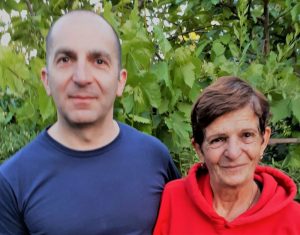 Today I’m visiting Angelo Eliades, of Deep Green Permaculture fame in Preston. I’ve done a little homework and am looking forward to my visit but, as I pull up in front of the cream brick house near High Street’s busy shopping strip, I start to wonder whether this is the right place. It’s not what I’m expecting: the façade doesn’t give any hint of a permaculture regime; instead, a handkerchief of lush grass and a row of very pretty standard roses complement the ’60s home’s facade. I check the number.
Today I’m visiting Angelo Eliades, of Deep Green Permaculture fame in Preston. I’ve done a little homework and am looking forward to my visit but, as I pull up in front of the cream brick house near High Street’s busy shopping strip, I start to wonder whether this is the right place. It’s not what I’m expecting: the façade doesn’t give any hint of a permaculture regime; instead, a handkerchief of lush grass and a row of very pretty standard roses complement the ’60s home’s facade. I check the number.
Suddenly a gate which separates the house from the garage opens and a bright-eyed, energetic young man, calls to me. It’s Angelo so yes, this is the right place but there’s no immediate talk of permaculture, at once we’re discussing a gap in the row of rose plants which are, I gather, a concession to his mother, Savoula’s gardening style (it’s her house). He’s angry and I can see why – one plant had been cruelly ‘removed’ by persons unknown. A disappointing introduction for both of us.
But Angelo is full of enthusiasm and eager to lead me up his garden path and, having heard about his accomplishments, I’m eager to see what lays behind that gate!
I’m confronted by a lush wonderland!
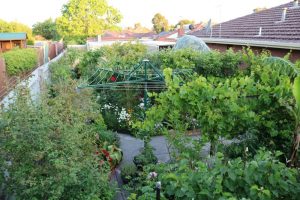 In this past year, I’ve seen quite a few gardens and been impressed in differing ways by all of them, but this is unlike any place I’ve visited. Before me is a narrow pathway lined with neat rows of water tanks and compost bins. Potted orchids’ bending spikes are loaded with exotic blooms and twisting grape vines bursting into leaf linger beneath the building’s eaves and dress its west wall. Beyond, I see the walkway opening onto a verdant mass dominated by greens, dotted with colour and defined by a myriad shapes within a huge variety of thriving plants. I see that many of the plants are food producers, others are medicinal herbs and others appear to be there to support their neighbours, perhaps to encourage beneficial insects, provide shade or just add to the aesthetics of the space. I’m impressed – I’ve never before seen such varied, thriving growth in such a small space.
In this past year, I’ve seen quite a few gardens and been impressed in differing ways by all of them, but this is unlike any place I’ve visited. Before me is a narrow pathway lined with neat rows of water tanks and compost bins. Potted orchids’ bending spikes are loaded with exotic blooms and twisting grape vines bursting into leaf linger beneath the building’s eaves and dress its west wall. Beyond, I see the walkway opening onto a verdant mass dominated by greens, dotted with colour and defined by a myriad shapes within a huge variety of thriving plants. I see that many of the plants are food producers, others are medicinal herbs and others appear to be there to support their neighbours, perhaps to encourage beneficial insects, provide shade or just add to the aesthetics of the space. I’m impressed – I’ve never before seen such varied, thriving growth in such a small space.
The seven levels of vegetation
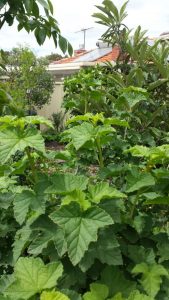 Angelo tells me that this is a ‘food forest’ and describes its structure as ‘seven levels of vegetation’ – I’m curious to hear more. He explains that the seven levels are canopy, sub-canopy, shrub, herbaceous, ground, below ground and vertical/climber and that they comprise layers planted to create climatic zones where plants can feed, protect and support each other. We’re about to explore this intensive application of a natural forest structure.
Angelo tells me that this is a ‘food forest’ and describes its structure as ‘seven levels of vegetation’ – I’m curious to hear more. He explains that the seven levels are canopy, sub-canopy, shrub, herbaceous, ground, below ground and vertical/climber and that they comprise layers planted to create climatic zones where plants can feed, protect and support each other. We’re about to explore this intensive application of a natural forest structure.
Before us are several winding paths navigating the cultivated spaces. They are inviting and we commence a journey through them. We walk between sun-catching alcoves and plants which are graduated to make full use of sunlight and slope from the highest canopy in the south down to the lowest at the back fence on the north side.
I see that some of the paths are packed with pots containing all manner of indigenous and exotic food producers and pollinators. Within the pots and plots there’s an amazing array of climbers, berries, succulents and even a water garden (over-run with soon-to-be-re-potted native rush Baloskion pallens ‘didgery sticks’). There is not a centimetre of ground left unused, save one bed which has been cleared for Savoula – a space for her to practise her traditional gardening methods.
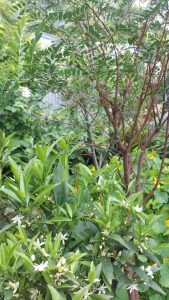 Angelo has a special interest in rare plants and proudly points them out, especially the tropical and sub-tropical fruit-bearing species. They include palms such as Dragon’s Blood Palm (Dracaena draco) and indigenous fruit bearers. His exotics include liquorice root, marshmallow, yerba mate, Siberian ginseng, citronella balm, vetiver grass, sambung, pepino, horehound and mullein, to name a few. They can be found hidden under blossom-laden apricot and apple trees or skirting flourishing banana spikes. Marigolds, nasturtiums, ageratum, orris root irises, comfrey, yarrow and tansy carpet the ground. There are, I hear, around 30 fruit trees planted in the ground plus others in pots, 22 kinds of berries, 60-70 medicinal herbs and dozens and dozens of ornamentals. All of them appear to be very comfortable in their ‘over-stacked’ environment.
Angelo has a special interest in rare plants and proudly points them out, especially the tropical and sub-tropical fruit-bearing species. They include palms such as Dragon’s Blood Palm (Dracaena draco) and indigenous fruit bearers. His exotics include liquorice root, marshmallow, yerba mate, Siberian ginseng, citronella balm, vetiver grass, sambung, pepino, horehound and mullein, to name a few. They can be found hidden under blossom-laden apricot and apple trees or skirting flourishing banana spikes. Marigolds, nasturtiums, ageratum, orris root irises, comfrey, yarrow and tansy carpet the ground. There are, I hear, around 30 fruit trees planted in the ground plus others in pots, 22 kinds of berries, 60-70 medicinal herbs and dozens and dozens of ornamentals. All of them appear to be very comfortable in their ‘over-stacked’ environment.
“Small scale intensive permaculture, over-stacked food forest design, no dig, natural pest control, low maintenance, self-sustaining.“
I wonder how much cultivation is necessary to maintain this oasis. Surprisingly little it seems – around two hours a week. The soil is built up by layering compost, manure (mostly cow) and mulch produced from plant trimmings. These ingredients blend to create humus, which feeds the soil and deters weeds.
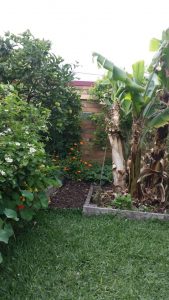 Angelo says that each plant has been placed to maximise the use of wind, water & light, and that each works with its neighbours to invite beneficial insects and birds whilst discouraging disease.
Angelo says that each plant has been placed to maximise the use of wind, water & light, and that each works with its neighbours to invite beneficial insects and birds whilst discouraging disease.
Some facts and figures
The whole block is a 600 metres square, but the house occupies most of it and only 64 square metres are cultivated. In the garden’s 4th year (2011), Angelo kept detailed records on what was harvested. In that year, there was 230Kg of produce (60Kg veggies, 160Kg fruit and 10Kg berries). This is equivalent to around 15 metric tonnes per acre which, Angelo tells me, compares with a yield of around 6-7 tons per acre annually in Europe’s best farms. The garden is now in its tenth year.
“It’s amazing how beneficial gardening is.“
Savoula comes out to see me just before I leave. She’s a vibrant woman, small and energetic. She’s also very generous, offering me lemons and herbs, especially a cutting of an arthritis herb which she uses, Angelo says, with great success – I’m interested as a family member has recently been 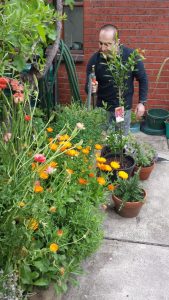 diagnosed with mild arthritis.
diagnosed with mild arthritis.
As she darts between plants with her cat, Louie, in tow, Angelo and I discuss the benefits of gardening. He tells me his mum re-discovered her own garden through his work here and now blends her love of orchids and herbs with an understanding of his exotics and indigenous plants. He says she’s fallen for lemon myrtle, loves the tea made with its leaves, and he has also noticed her plucking berries on her daily garden inspections.
Lightly electrified wires on the top of their backyard fences were installed to deter possums thus protecting her plants – a move that has made both of them very happy. This garden is his gift to her, a beautiful gift which is sure to contribute to her pleasure and good health.
I’m now loaded with produce, facts, figures, some cuttings and many images of a beautiful garden and we’re walking back through the garden gate, passing from a magical place to another more familiar one. I thank Angelo and Savoula for their hospitality and head for home. But that garden has had a lasting effect – in my mind, I’m still wandering through Angelo’s amazing seven layers of 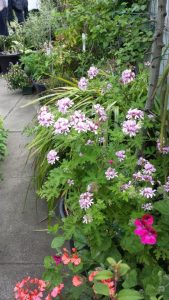 vegetation.
vegetation.
A footnote from Angelo
“The good news is that I’ve replaced the stolen rose for my mum and the front garden is now secured. She has under-planted her roses with yellow Bidens flowers so her front garden is now complete and all the roses are blooming!

Regarding your cabbages and cauliflower. During your dry summers, how often do you need to add water? If there is good moisture in your mulched 5-layered bed, what would you say is the reason that these two vegetables wilt during the hotter time of the day, and then they recover once the sun is off them?